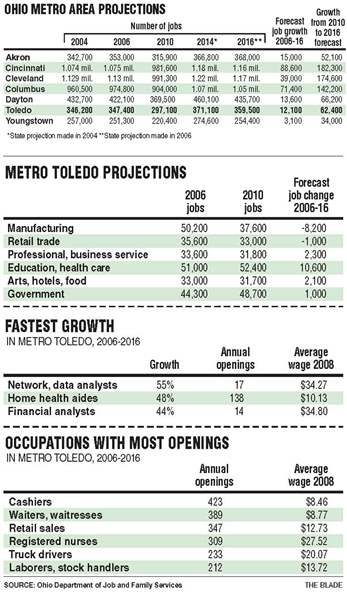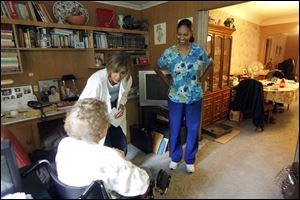
Crystal ball on jobs cloudy
Recession dashes outlook for gains in metro Toledo
5/29/2011

Home health care aide Laquita Jackson, right, and supervisor Laura Suder say good-bye after a visit to a Sylvania-area patient. The field of home health aides is one that has seen employment growth in the Toledo area.
Employment forecasting is not an easy job.
Five years ago, Ohio experts predicted a 7 percent rate of job growth in metro Toledo between 2004 and 2014. Two years ago, state experts projected 3.5 percent Toledo job growth between 2006 and 2016.
Both predictions now seem silly, given the Great Recession that began in 2007 and ended in 2009.
Instead of its employment climbing by nearly 25,000 jobs in the first study and by 12,000 in the second study, metro Toledo lost more than 49,000 jobs between 2004 and 2010 and would have to gain more than 62,000 jobs in the next six years to fulfill the second forecast.
"We couldn't predict 9/11 and we couldn't predict this last recession, and they both had impacts," explained Keith Ewald, chief economist with the Ohio Bureau of Labor Market Information.
The second study predicted slower growth, probably in part because the recession had begun, and job losses had started, when the report was compiled.
Mark Schweitzer, a labor economist with the Federal Reserve Bank in Cleveland, said job agencies in the Cleveland area also have begun to focus more on information from area employers rather than state forecasts.
"I've never been a big fan of these projections," he said. "I think they're hard to do because, No. 1, you're not going to hit the aggregate labor market trend unless things continue on the way that they were. So they don't know what's around the corner."

He said the reports are done as well as they can be, given the unknowns, but, he added, "If I'm an unemployed worker, what I'm concerned about is how many jobs are there going to be in this area. So the gross jobs numbers are very important."
Mr. Ewald, the state Department of Job and Family Services economist, said the forecasts generally hold true in terms of trends, such as which jobs are likely to be the fastest growing and those with the most annual openings.
"As an example, health care we predicted to be strong, and it's been relatively strong throughout this recession," Mr. Ewald said. "The occupations we suggest are the fastest- growing have been the fastest growing."
The state's 2006-2016 report, for example, identified network systems and data communications analysts as the fastest-growing occupation in metro Toledo from now through 2016, with an average of 17 openings annually and an average wage of $34.27 an hour.
It identified home health aides as the second fastest-growing, with 138 openings annually and an average wage of $10.13 an hour.
Jeff Boersma, president and chief executive of Modern Data Inc., a Toledo company that specializes in network systems and data communications, said the state's prediction of that being a hot job is dead on.
"We continue to add people and plan to grow significantly in the next five years," he said. His firm has about 20 employees and plans to triple that by 2016. "We certainly have plenty of work to keep our folks busy, and these days it's mainly about how fast you can work and grow."
Likewise, Coleta Schmidlin, regional director for Mercy Home Care in Toledo and Tiffin, said the need for home health-care aides has been rising steadily in metro Toledo and elsewhere. The demand led Mercy College of Northwest Ohio to add a training program for the occupation, she said.
"Where you see this skill predominantly is in nursing homes," she said. "I know many of the nursing homes run ads constantly for home health aides."
"This is a very, very tough job," she explained. "But the demand from clients for aides is increasing."
Mike Veh, work-force manager at The Source of Northwest Ohio, Lucas County's one-stop center for job seekers, said he and other agency officials are aware that state job forecasts can get skewed badly, so they are treated as general guidelines or starting points for advising clients on job training.
"It's difficult to advise people who are looking for work to say, ‘This is what you need' without accurate information, and some people can't wait five years for a job trend to develop," Mr. Veh said. The Source, which routinely had asked area employers about upcoming job needs, this year sent out a survey to 1,500 area employers to determine local job opening trends.
"We are trying to look at what the real situation is," he said.
The latest state study about metro Toledo predicts manufacturing jobs in the four-county metro area would drop by 8,200 from 2006 to 2016, but the decline by 2010 was approaching twice that figure.
Retail jobs were supposed to decline by 1,000 but already have slumped 2,600. Education and health-care jobs were forecast to rise 10,600 by 2016 and by last year were up just 1,400.
On the other hand, the last study predicted government jobs would increase by 1,000 by 2016 but already have climbed 4,300.
Ken Mayland, an economist with ClearView Economics in Cleveland, said predicting which industries will grow and which will recede has some merit. "If they have health care as being a leading industry, that makes perfect sense, given our demographics and the nation's seemingly better commitment to health care," he said.
But Mr. Mayland said such forecasts have a difficult time evaluating issues such as competitiveness and politics and how they influence job growth.
"I would definitely look at these with a big pile of salt because, again, there's the competitive issue, and other cyclical issues," he said.
Mr. Ewald said state analysts are to prepare a new 10-year forecast this year, using 2008 and 2009 data.
Although predicting job growth even as jobs are disappearing "can be confusing to people," he explained, a bigger problem is many people will just look at the overall job numbers and not at the finer details, such as changes in a particular sector.
"For example, take printing jobs. They need people, but traditional printing jobs are declining because of technology. The real need is for people skilled in the new technology, but it might look like the industry is declining," he said.
And the people in it need to acquire new skills, Mr. Ewald said. "So," he added, "you really have get into the details of things in these reports." Just focusing on the numbers, he said, could leave one disappointed.
Contact Jon Chavez at:
jchavez@theblade.com
or 419-724-6128.